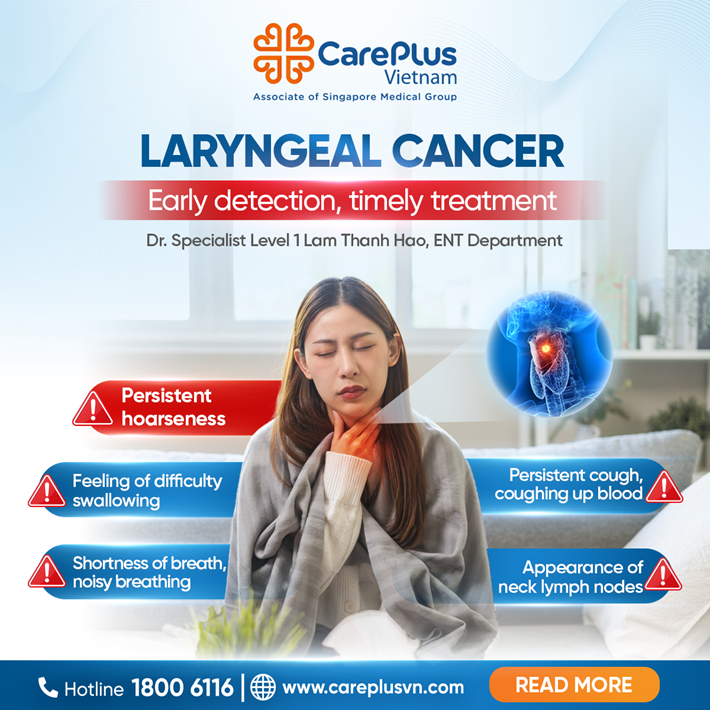LARYNGEAL CANCER – EARLY DETECTION, TIMELY TREATMENT
Laryngeal cancer occurs when malignant (cancerous) cells form in the tissues of the larynx. The larynx is part of the respiratory system located in the neck, connecting the pharynx (throat) and the trachea. It plays important roles in breathing, voice production, and protecting the lower airway.

9/18/2025 9:21:27 AM
Like other cancers, advanced laryngeal cancer can metastasize to other parts of the body, making treatment more difficult and prognosis poorer. Early screening and detection are crucial for effective treatment.
👩⚕️ Let’s learn more with Dr. Lam Thanh Hao (ENT Specialist, CarePlus Clinics) through the information below:
Epidemiology
- According to the National Cancer Hospital (Hanoi), laryngeal cancer accounts for about 2% of all cancers in Vietnam.
- More than 90% of cases occur in men.
- Most common in ages 50–70 (72%), followed by 40–50 (12%).
- However, the age of onset is becoming younger, and more women are being diagnosed compared to the past.
Risk Factors
- Tobacco and alcohol: The main, well-proven risk factors. Smoking combined with alcohol greatly increases the risk.
- Occupational/environmental exposure: Long-term exposure to wood dust, asbestos, industrial chemicals, and polluted environments.
- HPV infection: Especially HPV types 16 and 18 have been linked to laryngeal cancer.
- Gastroesophageal reflux disease (GERD): Chronic acid reflux irritates the laryngeal lining, increasing malignancy risk.
- Genetic, immune, and individual factors: Tumor suppressor gene mutations, family history, and immunodeficiency may contribute.
Symptoms
- Persistent hoarseness not improving with usual treatment – due to tumor affecting vocal cord vibration.
- Difficulty or painful swallowing – tumor obstructs swallowing pathway.
- Shortness of breath or stridor – tumor narrows the airway, causing partial or near-complete obstruction.
- Chronic cough, sometimes with blood – tumor irritation or blood vessel invasion.
- Neck lymph nodes – cancer cells spread through lymphatic pathways.
Diagnosis
- Clinical examination, imaging, and lab tests are essential.
- ENT endoscopy: Visualizes tumor location and characteristics.
- Biopsy: Confirms pathology, gold standard for diagnosis.
- Fine needle aspiration (FNA): If neck lymph node metastasis is suspected.
- CT scan: Assesses tumor size, invasion, and lymph node involvement.
- Chest X-ray, abdominal ultrasound, bone scan: For distant metastasis evaluation.
- PET-CT: Modern imaging for comprehensive staging.
Treatment Options
- Surgery: Tumor removal, partial/total laryngectomy, neck lymph node dissection.
- Radiation therapy: High-energy X-rays or other beams to kill or stop cancer cell growth.
- Chemotherapy: Intravenous or oral drugs to kill or inhibit cancer cells.
- Supportive care: Voice rehabilitation and speech therapy after laryngectomy.
Prevention
🔺 Do not smoke
🔺 Limit alcohol
🔺 Treat GERD thoroughly
🔺 Use proper protective equipment in dusty/chemical environments
🔺 Maintain oral and throat hygiene
🔺 Healthy lifestyle: balanced diet and regular exercise
Screening for Laryngeal Cancer
Screening combines clinical examination, lab tests, and imaging to detect disease early, even before symptoms appear. Early detection allows timely treatment, improves cure rates, and prolongs survival.
Who should undergo laryngeal cancer screening?
✅ Long-term smokers (cigarettes, pipe tobacco)
✅ Heavy alcohol drinkers
✅ Workers in polluted environments (wood dust, asbestos, fumes, chemicals)
✅ People over 40 years old, especially men
✅ Those with a family history of head & neck cancers